Your database can’t keep up.
Choosing a new system feels overwhelming. You’re stuck between outdated options and confusing new technologies, unsure which will handle future growth.
The fear of choosing a system with hidden limits can lead to decision paralysis. This puts your entire data strategy at risk.
Grandview Research reports relational databases hold a 64% revenue share. While dominant, their limitations with unstructured data can severely restrict future innovation.
But you can avoid these pitfalls. The key is to find a system that aligns with your future architectural needs, not just your current ones.
Speaking of future-proofing your data, my guide on authentication software for security can provide deeper insights into protecting your systems.
In this article, I’ll guide you through the best database management system options. We will compare them to help you make a confident, future-proof choice.
You’ll learn how to select a solution that reduces integration headaches and adapts to your evolving data models, ensuring long-term reliability.
Let’s dive in.
Quick Summary:
| # | Software | Rating | Best For |
|---|---|---|---|
| 1 | Microsoft → | Growing companies | |
| 2 | MongoDB → | Flexible, scalable firms | |
| 3 | PostgreSQL → | Stable, adaptable systems | |
| 4 | Redis → | Modern AI-focused enterprises | |
| 5 | MariaDB → | Growing open-source companies |
1. Microsoft
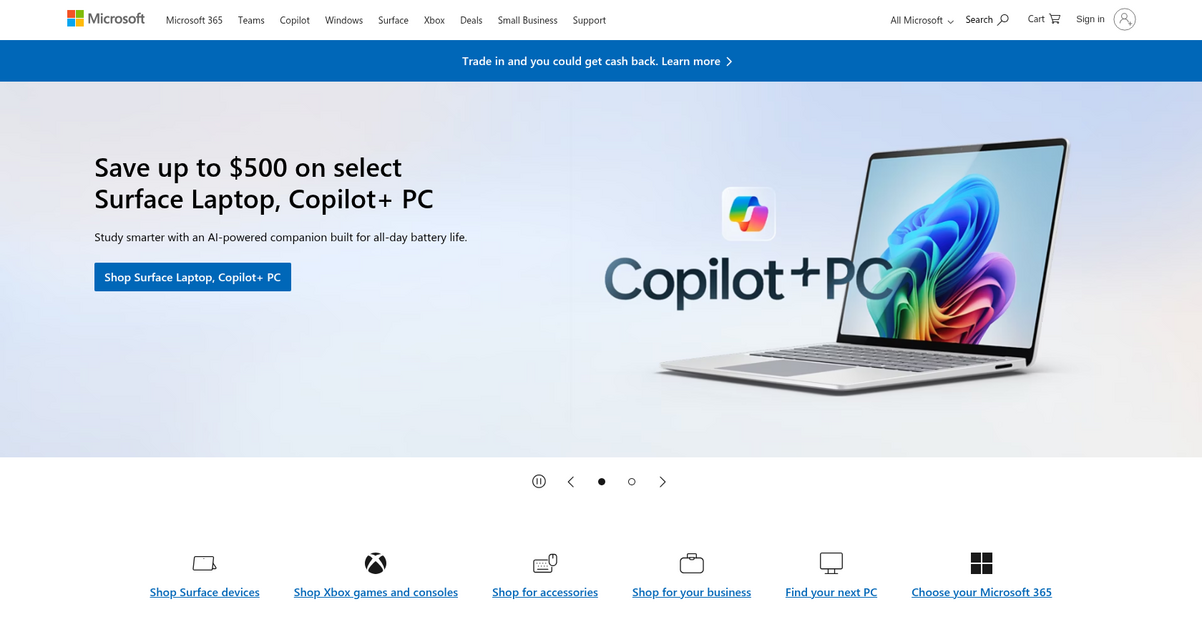
Struggling with database scalability and future-proofing your data?
Microsoft offers Microsoft Cloud and Azure, providing flexible, powerful solutions for your evolving data needs.
This means you can easily manage your data across various environments, ensuring your operations remain robust and responsive, especially with Windows 11 for Business designed for hybrid work.
Here’s how to achieve the extraordinary.
Microsoft 365 delivers essential cloud storage, advanced security features, and integrates Microsoft Copilot directly into your favorite applications, all within a single, comprehensive plan.
This means you can streamline your operations and enhance productivity by leveraging AI in Microsoft 365 for business, saving time to focus on what truly matters.
Additionally, with Visual Studio 2022, your developers get a comprehensive IDE for building web, cloud, desktop, and mobile applications, services, and games, ensuring you have the tools needed for modern data management and innovation. Plus, Microsoft Copilot acts as your AI companion, ready to support you wherever and whenever needed.
The result? Enhanced productivity and peace of mind.
Speaking of communication and efficiency, my guide on best cloud phone system explores how to streamline your business calls.
Key features:
- Microsoft Cloud and Azure: Provide robust, scalable cloud infrastructure crucial for modern data management, ensuring your data grows with your business.
- Microsoft 365 with Copilot: Offers integrated cloud storage, security, and AI capabilities within familiar applications, streamlining workflows and boosting productivity.
- Visual Studio 2022: A comprehensive IDE for developers, supporting diverse application types, which is essential for building and maintaining robust database-driven solutions.
Microsoft features, pricing, & alternatives →
Verdict: Microsoft offers a powerful ecosystem of tools, making it a strong contender for the best database management system for growing companies. Its focus on cloud solutions, AI integration, and developer support addresses key pain points like scalability and future-proofing, ensuring your team has the resources to manage complex data needs efficiently and securely.
2. MongoDB

Struggling with rigid database structures and scalability?
MongoDB Atlas offers a modern, AI-ready platform to build and scale your applications. This means you don’t need separate databases for transactions, rich search, or generative AI, simplifying your tech stack.
Your team can break free from rigid, tabular data structures with flexible documents that map directly to code objects, allowing for faster development and minimized computational cost.
Here’s how MongoDB Atlas steps in.
MongoDB provides a multi-cloud database, allowing you to deploy across various cloud providers, giving you unprecedented flexibility. Plus, its document data model maps intuitively to how you think and code, allowing for more agile development.
You can also deliver engaging search experiences with Atlas Search and design intelligent apps with Atlas Vector Search for generative AI. Additionally, it integrates with Kafka for stream processing and offers tools like Compass for GUI-based data management, streamlining your workflow and boosting productivity. This means your developers can rapidly innovate, managing both operational and vector data in one place, which reduces redundant processes and simplifies complex queries, a game-changer for many teams.
The result: a unified, high-performance solution.
Key features:
- Flexible Document Data Model: Adapts to evolving data needs, mapping directly to code objects for intuitive development and increased performance by embedding related data.
- AI-Ready Platform with Vector Search: Powers intelligent applications, integrates with generative AI tools like Voyage AI, and includes dedicated vector search capabilities for advanced AI development.
- Multi-Cloud Deployment & Integrations: Offers multi-cloud database deployment for flexibility and integrates with over 100 popular technologies and third-party services, including Kafka.
MongoDB features, pricing, & alternatives →
Verdict: MongoDB Atlas is positioned as the best database management system for companies seeking flexibility, scalability, and AI integration. Its ability to handle diverse application requirements, from transactions to generative AI, coupled with high availability and efficient resource utilization, makes it an excellent choice for future-proofing your data infrastructure.
3. PostgreSQL

Are hidden scalability limits causing you headaches?
PostgreSQL offers a powerful, open-source object-relational database system, perfect for modern data needs. This means you can confidently manage growing datasets without unexpected constraints.
With over 35 years of active development, PostgreSQL has earned a strong reputation for reliability, feature robustness, and performance.
It’s time to simplify your data management.
PostgreSQL’s robust features ensure your data is always available and performs optimally, even as your requirements evolve. This means you gain the flexibility needed to adapt to changing data models, including those for microservices.
You’ll find a wealth of information in its official documentation, enabling easy installation and use. The active open-source community provides extensive support and resources, allowing you to seamlessly integrate the system and enhance your skills. Additionally, regular releases and beta previews, like PostgreSQL 18 Beta 1, highlight continuous improvements and new features, giving you access to cutting-edge capabilities and ensuring long-term adaptability.
The result is reduced integration burdens and minimized latency.
While we’re discussing system capabilities, my article on best conversational AI platforms might also interest you.
Key features:
- Object-Relational Database System: A powerful, open-source system with a reputation for reliability, feature robustness, and performance, perfect for complex, evolving data models.
- Active Development & Community Support: Over 35 years of continuous development ensures stability, while a vibrant community offers extensive documentation and troubleshooting resources.
- Reliability and Robustness: Proven track record of securely storing and managing data, making it a dependable choice for critical business applications and future data needs.
PostgreSQL features, pricing, & alternatives →
Verdict: PostgreSQL’s long-standing reputation for reliability, robust features, and strong community support makes it an excellent candidate for the best database management system. It effectively addresses concerns about scalability and future-proofing, providing a stable and adaptable foundation for your data architecture.
4. Redis
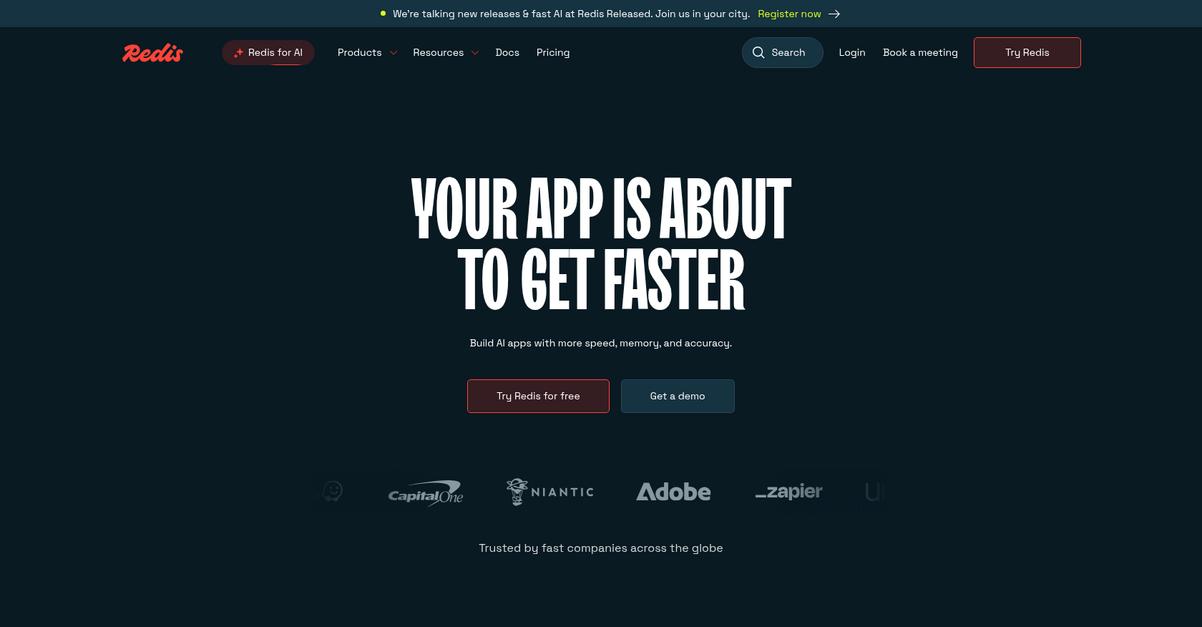
Struggling with database complexity and scalability limits?
Redis offers robust features like a vector database and semantic search, directly addressing your need for modern data capabilities. This helps you overcome challenges with traditional systems that lack support for advanced data types like JSON or geospatial information.
You need a solution that truly performs.
Redis provides a powerful in-memory database solution that delivers exceptional speed and accuracy, particularly for AI applications. It offers a fully managed semantic caching solution with Redis LangCache, helping you lower latency and LLM costs significantly. Additionally, tools like Redis Insight provide a free graphical user interface for developing, debugging, and visualizing your data, while Redis Flex lets you cache 5X more at no extra cost. This means you can run powerful data queries and search in real-time, instantly syncing data from your existing database.
The result is a system ready for your future needs.
Key features:
- Active-Active Geo Distribution: This provides 99.999% uptime and local sub-millisecond latency, ensuring your data is always available and responsive, even across diverse geographic locations.
- Multiple modern data structures: Work with 18 modern data structures, including vector sets and JSON, giving you the flexibility to handle complex and evolving data models with ease.
- Flexible deployment options: Choose to run Redis anywhere, whether in the cloud, on-prem, or in a hybrid environment, allowing you full control over your infrastructure.
Redis features, pricing, & alternatives →
Verdict: Redis stands out as a compelling contender for the best database management system, especially for companies looking to future-proof their data needs. Its focus on speed, AI integration, and flexible deployment, combined with enterprise-grade compliance and reliability, makes it a top choice for modern data challenges.
5. MariaDB
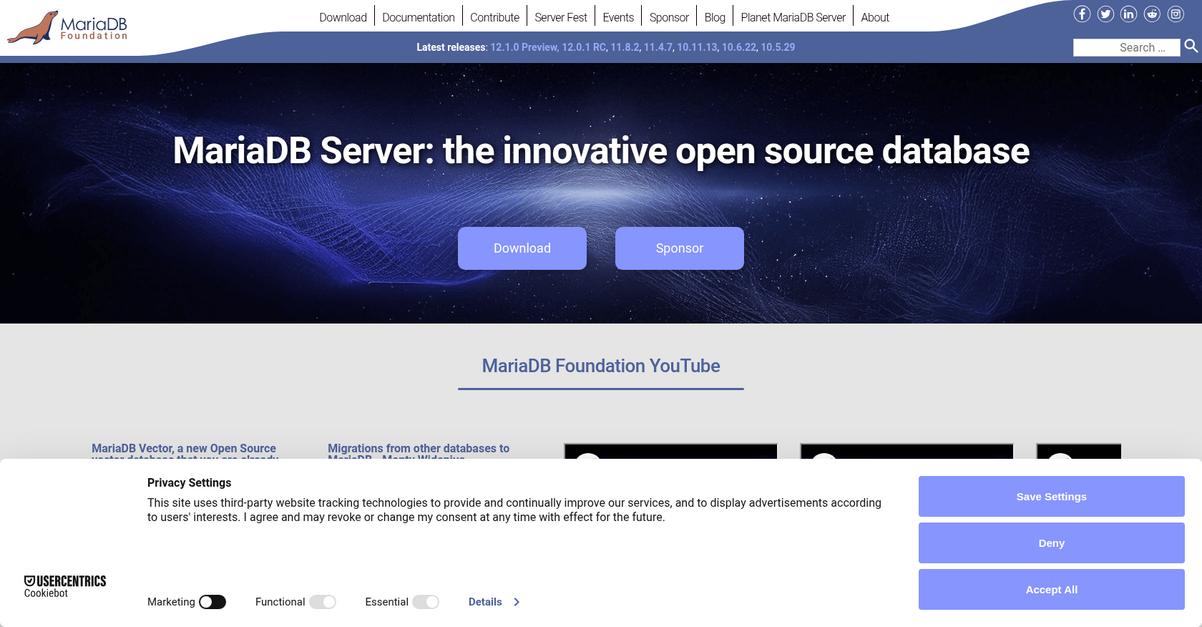
Struggling with database scalability and future-proofing your data?
MariaDB offers an innovative open-source relational database, built by the original MySQL developers, ensuring continued openness. This means you gain a flexible system that adapts to your evolving data needs.
Their latest features, like advanced clustering with Galera Cluster 4, provide the reliability and performance your growing company requires. This ensures your data infrastructure can handle increasing loads effortlessly.
Embrace an open-source solution.
MariaDB is designed for performance, stability, and openness, making it a reliable choice for managing your data. Its compatibility features with Oracle Database and Temporal Data Tables allow you to query historical data. This capability is crucial for audit trails and analyzing past states, addressing compliance and reporting challenges directly.
You also get a new Open Source vector database, MariaDB Vector, streamlining how you handle complex data types. This extensibility supports modern application demands like AI and machine learning. Additionally, MariaDB’s presence in most cloud offerings and Linux distributions reduces integration burdens and minimizes latency, making it easy to deploy across various environments.
Your data needs are future-proofed.
Key features:
- Open Source Core: Guaranteed open-source, providing transparency, community support, and flexibility for your data architecture without vendor lock-in.
- Advanced Clustering: MariaDB includes Galera Cluster 4, offering robust high availability and scalability for your critical applications and rapidly expanding data volumes.
- Temporal Data Tables: Query your data as it appeared at any point in the past, a powerful feature for auditing, compliance, and complex data analysis requirements.
MariaDB features, pricing, & alternatives →
Verdict: MariaDB is a strong contender as the best database management system for growing companies. Its open-source nature, advanced clustering, and temporal data tables help you overcome scalability concerns and budget constraints, future-proofing your data infrastructure with powerful and flexible capabilities.
6. Amazon RDS
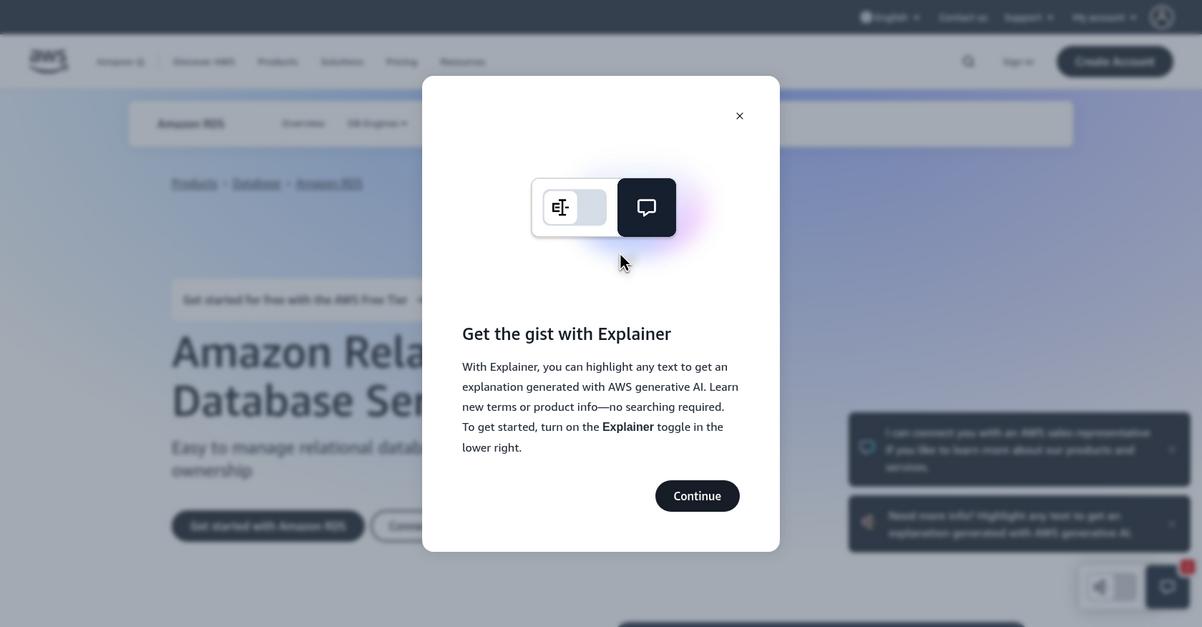
Tired of complex database management?
Amazon Relational Database Service (RDS) automates administrative tasks like provisioning and patching. This means you can focus on innovation, not infrastructure headaches.
You can create a new database in minutes, with flexibility to customize across eight engines. This directly addresses the challenges of evaluating options and seeking optimized replacements.
Move beyond tedious, inefficient database administration.
Amazon RDS solves your pain points by eliminating time-consuming tasks without needing to provision infrastructure or maintain software. You gain back valuable time for strategic work.
Here’s how: you can deploy and scale your chosen relational database engines, like PostgreSQL or MySQL, in the cloud or on premises, benefiting from high availability with Multi-AZ deployments. This simplifies decision-making, offering clear comparisons and reducing hidden scalability limits.
Additionally, Amazon RDS supports Graviton3-based instances for optimized performance and offers price predictability. Plus, it enables building generative AI applications with improved query performance and supports zero-ETL integrations for near real-time analytics. This aligns with future-proof architecture needs.
The result is streamlined database operations.
Key features:
- Automated database management removes the heavy lifting of provisioning, configuring, backing up, and patching, freeing your team for higher-value tasks.
- Extensive engine choice including PostgreSQL, MySQL, MariaDB, SQL Server, Oracle, and Db2, offering the flexibility to use familiar software in a managed environment.
- High availability with Multi-AZ deployments ensures robust system reliability and minimizes downtime risks, crucial for maintaining stakeholder expectations.
Amazon RDS features, pricing, & alternatives →
Verdict: Amazon RDS emerges as a strong contender for the best database management system, offering a comprehensive solution that tackles scalability, cost, and operational complexity. By automating routine tasks and providing flexible engine choices and high availability, it directly addresses the core challenges faced by database administrators and technical leaders.
7. Neo4j

Struggling with complex data relationships and slow queries?
Neo4j’s graph database stores your data as connected nodes, mirroring real-world relationships. This means you can quickly uncover hidden insights.
You’ll find it helps adapt to changing needs and make smarter decisions faster, especially in areas like fraud detection. This allows your organization to build what others can’t.
Now, let’s explore the solution.
Neo4j offers robust tools to streamline your data management. It runs queries up to 1000x faster than traditional relational databases by eliminating the need for complex JOINs.
Plus, you can slash schema design time from months to days, thanks to a data model that intuitively mirrors real-world relationships. Additionally, the Aura Graph Analytics service provides over 65 ready-to-use graph algorithms, letting you extract deeper insights from any data on any cloud without complex ETL processes. The result is better decisions and strategies by exploring hidden connections in your data.
It’s the world’s most-loved graph database.
Speaking of unifying data and insights, my guide on customer experience management software explores how to manage your CX data effectively.
Key features:
- Fast Query Performance: Achieve up to 1000x faster queries than relational databases, avoiding complex JOINs and providing rapid access to connected data.
- Flexible Data Modeling: Cut schema design time significantly by intuitively modeling data to mirror real-world relationships, adapting quickly to evolving needs.
- Powerful Graph Analytics: Leverage 65+ ready-to-use graph algorithms for deep insights from any data on any cloud, enabling better decision-making.
Neo4j features, pricing, & alternatives →
Verdict: If you need the best Database Management System that excels in understanding complex data relationships and delivers lightning-fast queries, Neo4j is an excellent choice. Its graph-native approach and robust analytics capabilities, including support for Generative AI with GraphRAG, make it ideal for uncovering hidden patterns in your data for fraud detection and other critical use cases.
8. Snowflake
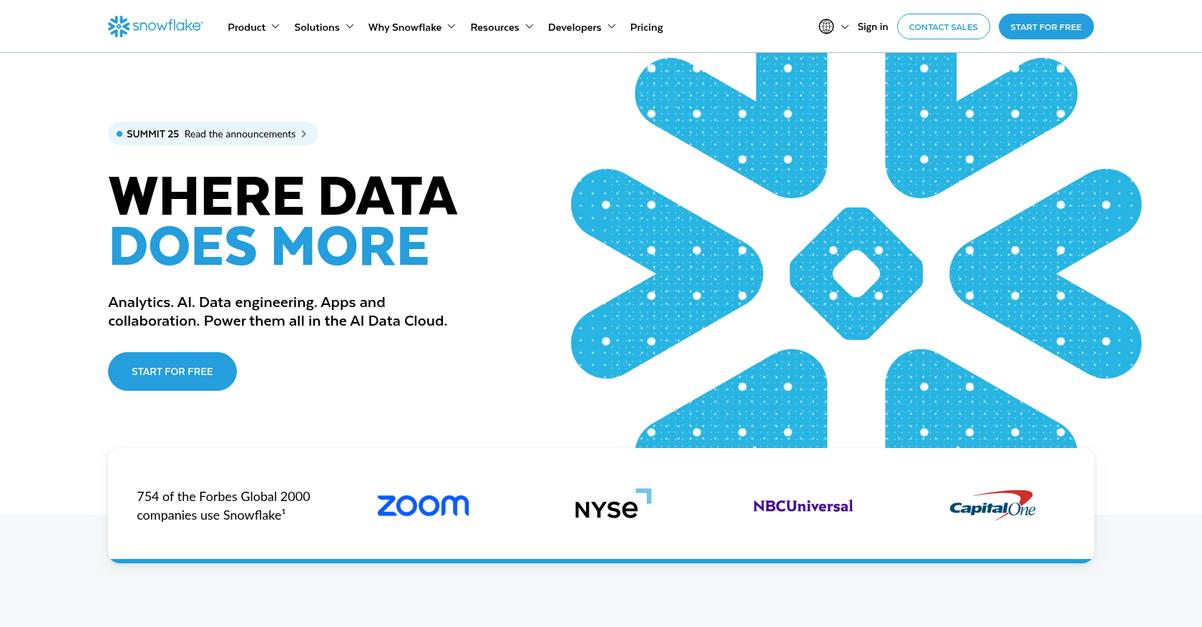
Struggling with complex data infrastructure?
Snowflake offers a fully managed platform to develop AI products and apps securely. This means you can innovate faster across any data type or scale.
This solution helps you move data effortlessly, offering instant access to industry-leading LLMs for AI model creation. You can easily overcome data silos.
Simplify your enterprise data needs.
Snowflake simplifies your data and AI strategies by providing an easy-to-use, integrated platform across various data types and clouds, saving you significant time on infrastructure setup. This allows your team to focus on insights, not maintenance.
You can streamline your architecture and smash data silos, supporting demanding workloads with built-in security, governance, and disaster recovery. This platform is truly easy to use, connecting your entire data estate and enabling privacy-preserving data collaboration. Additionally, you gain robust capabilities for building and sharing data and AI applications, along with interactive development environments.
This powers your AI, apps, and data effectively.
Before diving deeper into database solutions, you might find my analysis of best remote support software helpful for overall IT management.
Key features:
- Fully managed platform: Simplifies data ingestion, processing, analysis, and modeling, allowing you to innovate faster and maximize value from all your data, apps, and models.
- AI and ML capabilities: Securely create and deploy custom LLMs and ML models using Cortex AI and Snowflake ML, turning paper-based information into actionable data for faster insights.
- Cross-cloud collaboration: Connect your business ecosystem, share live data across clouds and organizations, and easily develop and distribute applications with seamless experiences.
Snowflake features, pricing, & alternatives →
Verdict: Snowflake stands out as a strong contender for the best database management system, particularly for organizations seeking unified security, governance, and disaster recovery regardless of cloud or region. Its ability to simplify enterprise data and AI, coupled with cost optimization, makes it a compelling solution for scaling data needs.
Conclusion
Is your current database future-proof?
Choosing the wrong system locks you into hidden scalability limits. This decision puts your entire data strategy and future company growth at risk.
SNS Insider projects the U.S. market to reach $64.93 billion by 2032, driven by cloud adoption. This massive shift proves legacy systems can’t keep up, highlighting the urgent need for a modern, scalable platform.
Here is my top recommendation.
After reviewing all the options, I believe Oracle is the strongest choice for any organization that is serious about performance and scalability.
Its Autonomous Database handles complex tasks like security patching and performance tuning automatically. It’s truly the best database management system for future-proofing your infrastructure and freeing up your team.
If your organization also manages student information, explore my article on student information system for valuable insights.
I recommend you start a free trial of Oracle to see how its self-driving capabilities can transform your data management strategy.
It’s a true enterprise-grade solution.






